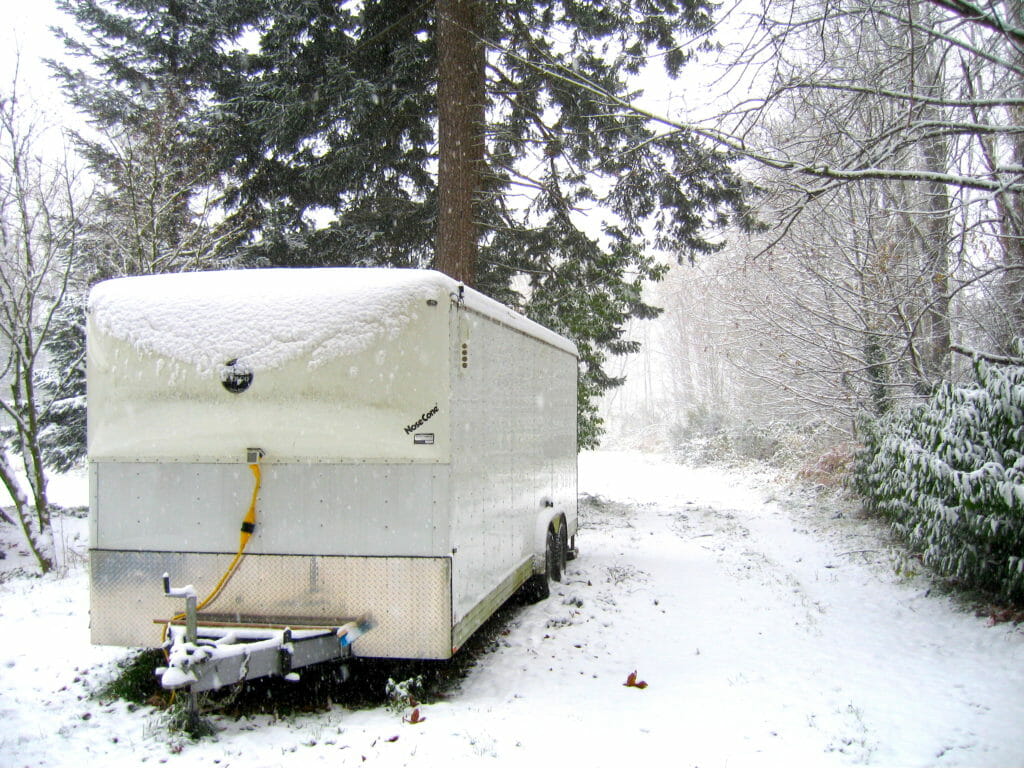
Adventures in a Geek Playpen
Oh good grief… has it really been 5 months since the post about clawing our way off a lee shore with a failed anchor windlass? It seems ages ago, back when leaves were on trees, the sun shone late into the evening, and I was lulled once again into the complacent fiction that sweet summer would last forever. Time slipped away with too little sailing, too many lists, and not enough of the fun that really is the bottom line.
Now the forest is naked, it’s been dark since about 4 PM, Christmas just jangled by (as surreal as ever), and there is an impossible backlog of bloggage. I’ve let Facebook, Twitter, and my live page be the safety valve for news, and that has delayed the production of more substantial and enduring efforts. There has been good progress on multiple fronts, however, so let’s dive in:
Mobile Lab
It has become clear that I’ve been in a cushy trap for quite a long time – huge building for geekery and cozy little house in an isolated forest setting, my nautical escape pod too far away in a marina. This translates into absurd inefficiency, with infrequent “work trips” truncated by the need for parts or tools. Time… just… passes… and when I see ads for shiny new versions of yet-uninstalled hardware on the shelf, alarm bells go off in my head.
We did spend quite a while on a quest for alternative real estate near marinas, investigating purchase and rental options, but in this market the thought of trying to get a bridge loan is daunting and I’m not drawn to either side of the landlord/tenant equation. So after much time spent chasing around, that idea fell by the wayside; the goal is to move aboard, not shuffle home base facilities. We recently looked into the seemingly mad idea of getting a second (much smaller) boat for Sky and her dog, allowing me and my cat to wallow in geeky clutter aboard Nomadness until the cows come home. That still doesn’t solve the lab-far-from-boat problem, however, though it may become rational when tonnage-reduction asymptotes and we find ourselves wanting to seed the technomadic flotilla.
The real problem is deceptively simple: having workspace near the boat. So, as I discussed back in April, I’m building a mobile lab named Polaris that can be parked in a marina and provide enough R&D; facilities to get me through this project. Progress on that has moved in spurts, and it is shaping up well: the trailer now has insulation, shore power, breaker panel, general lighting, and all major furniture installed. I am about to start incorporating inventory, building a DC power system with the boat’s old inverter/charger, and adding a small machine shop in the stern with a dust-control curtain to keep flying aluminum chips away from ones made of silicon. (A much more detailed article about the mobile lab is here.)
Here’s the power panel, built into a hinged door on the front wall where the nose cone provides plenty of clearance:
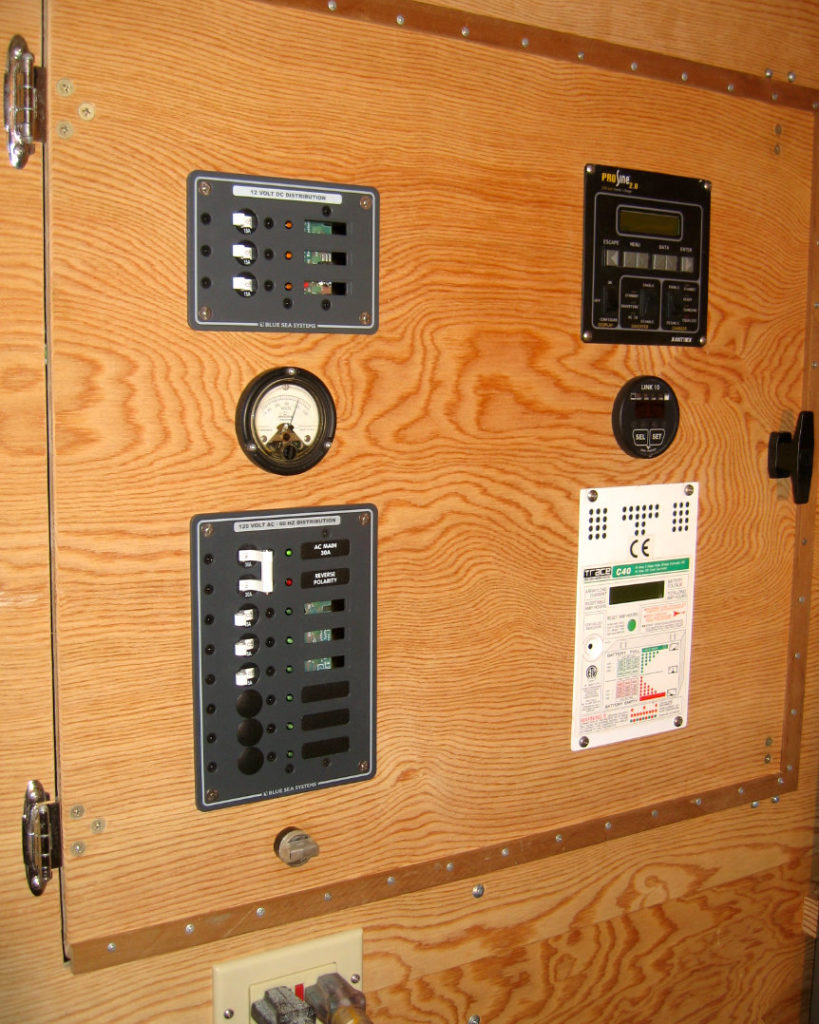
Those are Blue Sea Systems marine AC & DC breaker panels on the left, with a retro AC voltmeter in the middle. The right column is the Prosine 2.0 panel, LINK battery monitor, and Trace C40 solar charge controller. The black knob on the right is a Southco latching system with two rods that are guided into wooden receivers top and bottom; this allows easy access for service.
Shore power is a 50-foot 30-amp marine cable, with a pigtail at the distant end adapting it to the RV standard when needed. This keeps the hardware interoperable with the boat, and the whole lashup is a precise replica of a typical small-boat power system… providing a development environment for two of the Arduino-based nodes that are part of the Shacktopus network that runs the ship.
In the furniture domain, there is a beautiful steel desk at the bow (port side), followed by a massive wooden bench modified to clear the wheel well. On the starboard side, there is a combination steel file/drawer cabinet at the bow, followed by the man-door, a small cabinet for trailer-related hardware, a stainless tool chest, the “inventory bench” I built ages ago for a previous mothership, and the standing workbench that will carry power tools. All this is stuff repurposed from my lab, and has so far been free:
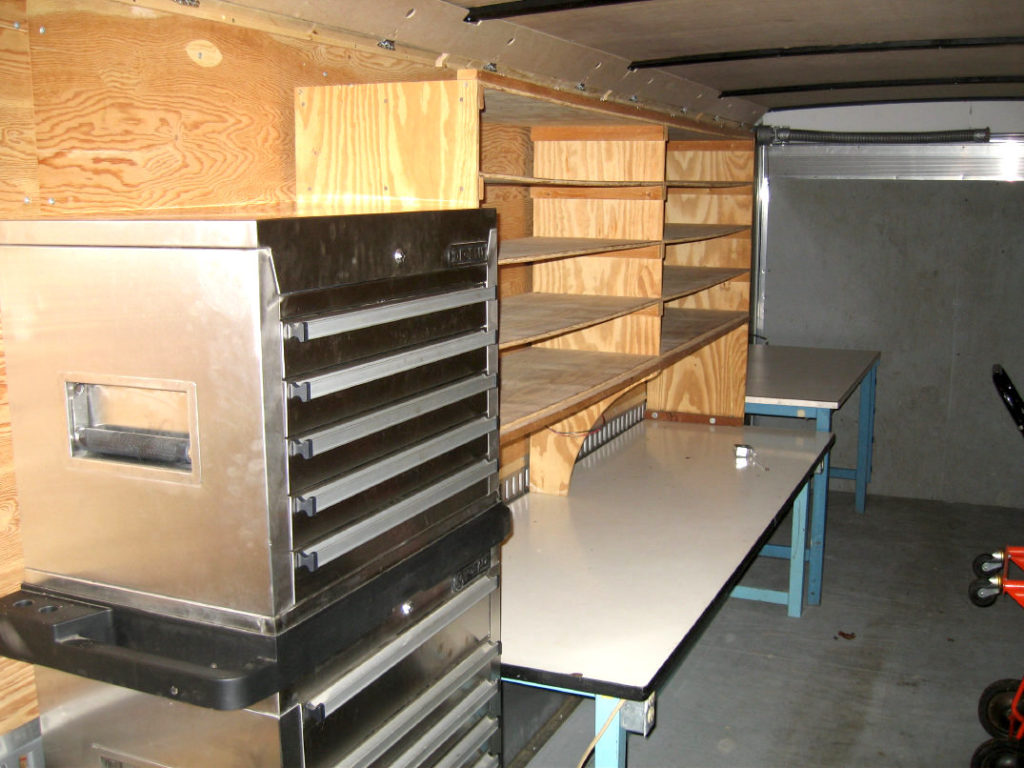
Once I finish bolting everything down and wiring AC and DC power to the benches, the fun begins: cherry-picking the choice bits out of my sloppy 3000 square-foot building and packing them efficiently into 6.4% of that. Obviously, my old “never know, might need it someday” criterion for what to keep will no longer apply. I may miss a few things, but it is going to be a joy to walk (imagine!) from Nomadness to Polaris, roll up my sleeves, mill a slot in a hunk of polycarbonate, solder up a cable, and saunter back to the ship to knock another couple of things off the to-do list.
Ship Power System
Aboard the boat, one of the most critical tasks has finally been completed: extracting the finicky old power-management system and installing an all-Outback solution. This consists of an inverter/charger, a control panel known as the MATE, a monitoring node with three shunts, a maximum power point solar charge manager, and an ethernet hub tying them all together. The MATE makes data streams from all components available via a serial port, so this will be a key data-collection project to allow observing the system from afar and plotting historical data.
I did a quick temporary plywood packaging hack where the old hardware was located, including an exit vent for new fans that can be automatically turned on when things get hot (a feature missing from the original system, requiring 50% derating during heavy charge).
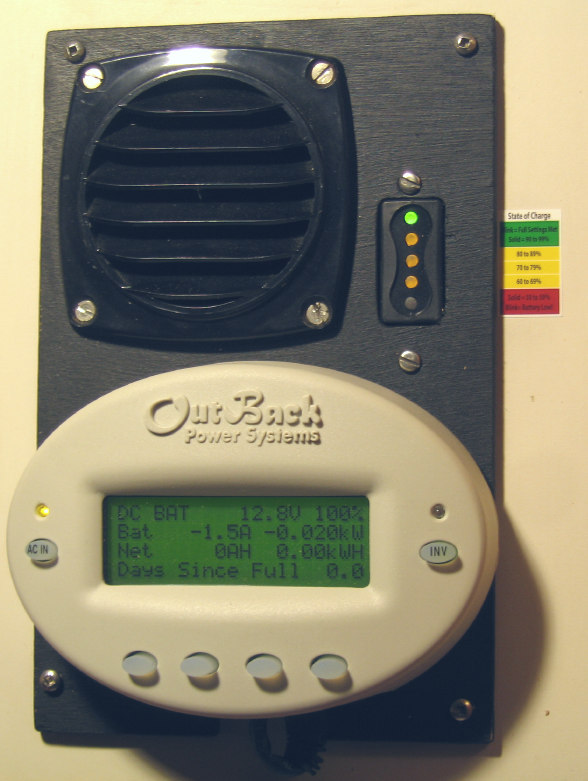
Once this region of the power panel (adjacent to the Bridge) is rebuilt, this will be more elegantly integrated… but it’s great to see the batteries being managed properly. The old gear is not going to waste; it’s been reassigned to the mobile lab.
The Playpen
My plan ever since acquiring the boat has been to convert the original nav station into an equipment console, so much of the planning involved just how, exactly, to shoehorn everything into such a small space… yet keep it serviceable. Unfolding onto the chart table was the general plan, but I was dreading the cabling and general back-breaking access issues in what was basically a blind corner.
It occurred to me recently that there is no reason to cram this geekery into a restrictive space. I consider the system integration project to be central to the entire mission of the boat, and have decided to reawaken the spirit that drove the Winnebiko and BEHEMOTH projects. The bike became an iconic technomadic substrate because the incorporation of cutting-edge computing and communication tools was my primary design goal… not an afterthought or something that had to be tucked away discretely in packs.
Like the bike, the boat is a platform for my life’s enduring passion… and that is not something that can thrive when banished to a distant hobby room.
Sooooo, space constraints have relaxed. Here’s the area that is about to change dramatically:
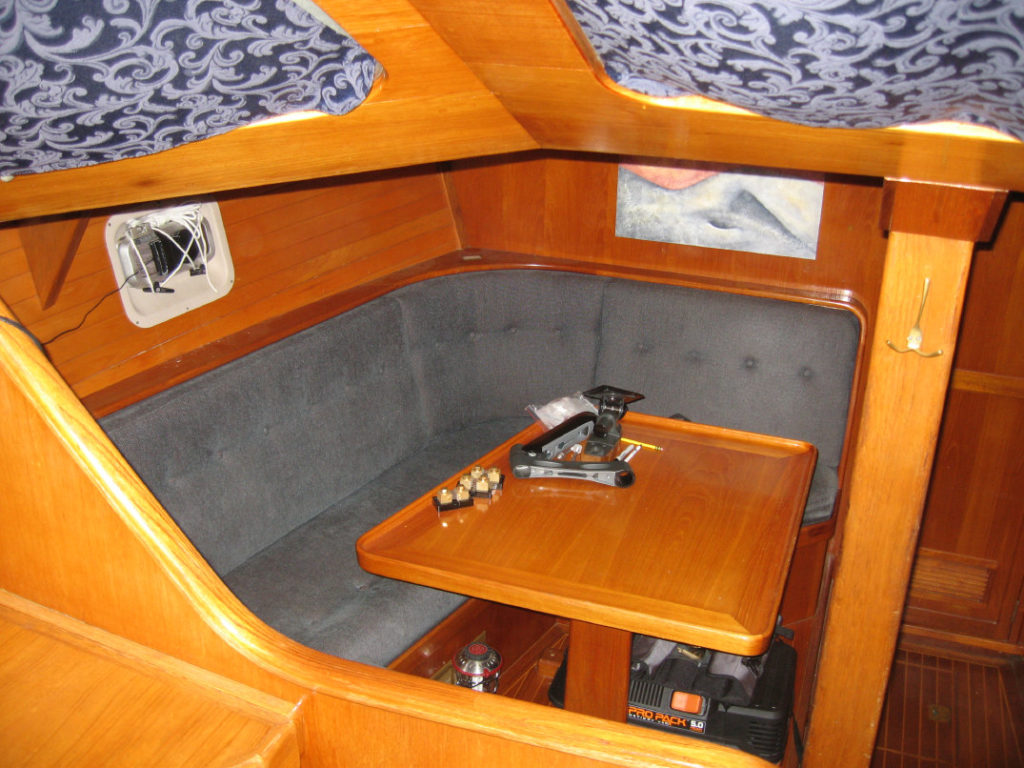
I’ve never much liked this space, even though the table is beautifully made; I can’t fit my galumphing body into the end near the mast partner, and the seats are uncomfortable. It usually ends up being a storage space for clutter, cleared occasionally for dinner or a spirited round of Mexican Train.
The new plan is a complete inversion, with a swivel chair replacing the table, wrap-around desktop that does not interfere with existing stowage below the seats, and 3 or 4 sloping-panel consoles (maybe 19″ rackmount, though there is little reason to adhere to that standard). Integrated into the long part of the desk is a full-size digital piano, with a hinged cover that allows conversion between music studio and lab space.
The console segments are much more accessible than the one that was planned for the nav station space, each consisting of two or three surfaces: horizontal base substrate that can pull out from the cabinet for major service, hinged front panel that lays down on the desk, and optional top panel hinged off of that and supported at the distal end by rollers in mounted channels. I believe there will be three major enclosures, with a smooth segue into a fourth zone for test equipment and tools.
Most of the intense geekery is in the “System” console, containing the Linux server, Mac Mini, Time Machine backup drive, hierarchy of USB hubs and related serial stuff, router and other networking tools, local sensors, resource management, speech I/O hardware, video, monitor screens, and so on. This will be in the foreground on the photo above (I’d be facing the camera when using it), and the swing-arm LCD monitor will “park” on top of it and blend into the workspace. That monitor can also swivel to face the Bridge for charting use when underway, or land at the nav station desk for voyage planning and other pilothouse applications.
The second console, mounted at an angle to the first and in the forward left corner of the photo, is devoted to communications… voice/data radios and related tools. That turns out to be quite a bit of front-panel hardware, and also involves a few “black boxes” that need free airspace for cooling… those go in a loose enclosure on top, along with a coax patch panel, probes for the SWR/wattmeter, antenna analyzer, and so on.
Third, just above the piano and continuing the wrap-around console theme, is the audio system. This includes the stereo, studio mixer and control surface, podcasting studio equipment, and editing tools. Presumably, the swing-arm monitor can park close enough to this to be useful, as the Mac is essential for digital audio work.
Finally, the distant corner and far wall in the photo are spaces devoted to hackage, tools, test equipment, and other “workbench” activities. This should be vastly more pleasant than my current low “tool drawer” with everything in roll-up pouches; using that system is inconvenient enough that I end up not putting things away (and there’s no dedicated workspace).
This whole description is still a bit speculative, as I have not yet done the essential reality check of removing the table, parking a chair in its place, and using my CAD system (cardboard-aided design) to cobble an actual-size mockup of what my old friend Frank Feczko dubbed the Playpen. Things will get more clear once that “human factors” design is done and I’ve had a chance to sit and stare at it for a few hours.
Shacktopus
What is suddenly more real, however, is the overall network design. The liberating vision described above prompted me to do something that has been on my list for months: create a module-level drawing of the entire ship system. The granularity on this is 1:1, with each object on the drawing corresponding to an actual physical device.
The full-size OmniGraffle drawing fills 18 pages, though it prints readably on 8.
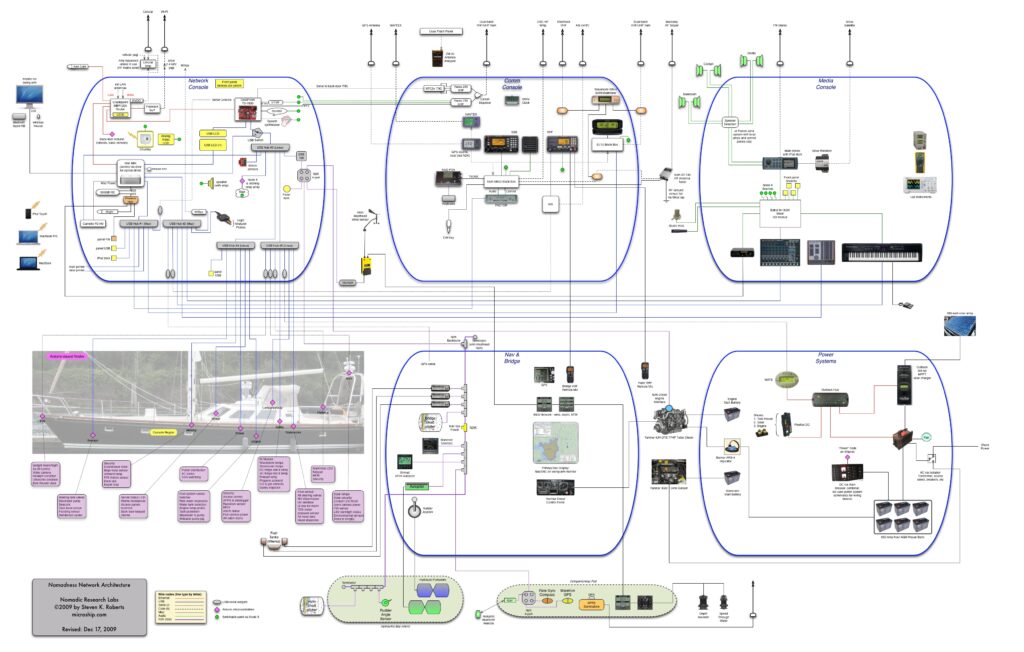
The best part about this is an unexpected psychological effect… for months, I’ve had a background process in my brain that has been continuously refreshing and refining this system. Since it wasn’t yet documented, I couldn’t fully let it go. After about a week of work on this drawing, however, I was able to free wetware resources for other things (like console packaging). Mental backups are just as important as those of the hard-disk variety!
There’s enough detail in the clickable image above to quickly run through the overall design. Each of those five blue rounded rectangles is a major console zone: across the top are the three described above (Systems, Comms, and Audio); the bottom right is power, and bottom center is the pilothouse Bridge including NMEA2000 and navigation. Breaking from that organizational level, the graphic at the lower left shows the location of all the Arduino nodes around the boat, with a brief summary of each.
A big part of the system console is simply signal routing… those five long gray rectangles are USB hubs, and the ones owned by the red Linux board also pass through a switch that allows them to be picked up by the Mac. I have my software work cut out for me.
In a somewhat related aside, I drove to Silicon Valley last month for my favorite conference, and while there made a pilgrimage to my bike at the always-enchanting Computer History Museum and visited a few dear old friends. Enroute back, I spent an otherwise boring night in Williams… but chanced to go to a little Chinese restaurant. The food was OK, but the fortune cookie was perfect:

Firing up the TS-7800
The two serious computers in the console system are the Mac Mini with wireless keyboard and mouse (now in regular use here, since my clunky old MacBook Pro won’t accept a Leopard install) and the Technologic TS-7800 Linux board. We just fired up the latter for the first time a few nights ago, and are now in the early phases of that non-trivial learning curve.
The first hurdle was silly, but difficult… the board’s little piggyback switching regulator (allowing a wide input voltage range) did not have its input polarity labeled. I was surprised to find nothing on the manufacturer’s website about this, nor even in the Yahoo TS-7000 group archives, and the board itself was surprisingly inscrutable. The cost of an error here is high, and finally, after much Googlage, I found a comment on a forum where someone had fried his protection diodes by guessing wrong. So here, to simplify future attempts by other people to solve this mystery, is the answer:
Looking at the edge of the board with the power connector, +12 goes on the left pin of the OP-SWITCHREG (closest to the PC-104 header), and GROUND goes on the right, close to the three jumpers… as shown in the photo:
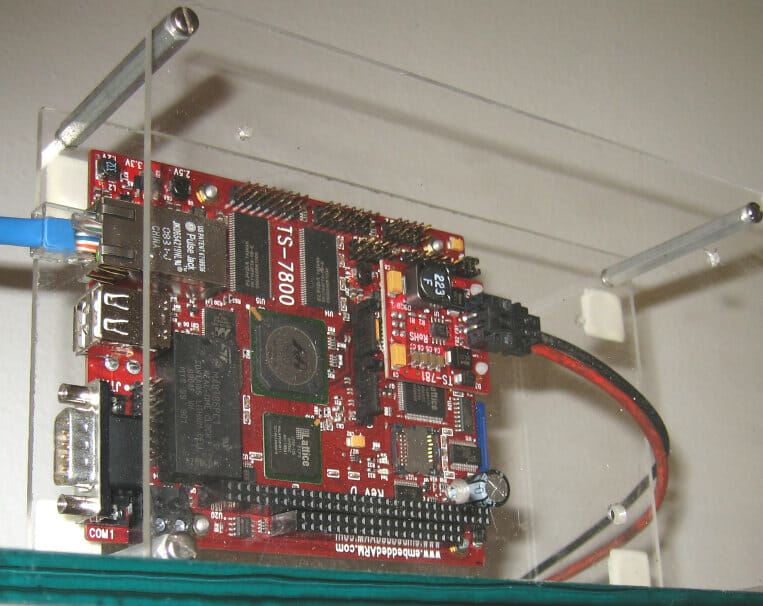
Anyway, once we avoided letting the smoke out and made a backup of the SD card image, the board came up and booted Linux as promised… whereupon we set up user accounts, SSH, encryption keys, and so on. Unfortunately, it seems to have come with an older version of Debian Linux – old enough that apt-get doesn’t recognize the structure of the new archive – so we couldn’t install the essential sudo to allow temporary root privileges while safe in a user environment. The current status of this project is thus squarely in the sysadmin domain, trying to figure out how to update the distro and otherwise get to the point where the fun stuff can begin.
I did try a sensor hello-world with the on-board SPI temperature sensor, but got a segmentation fault when I compiled and ran the included demo code. Ahhhh, learning curves.
The funny psychology here is that I still think of a board this size as a lightweight microcontroller. It feels weird to log into it via the LAN, run top, and see it frittering away on tasks various; it’s vastly more powerful than what I would have considered “Big Iron” during the BEHEMOTH epoch. But more complexity means more head-scratching; here’s Linux wizard Dave Warman, muttering about the 2007 Debian version in a brand new board:
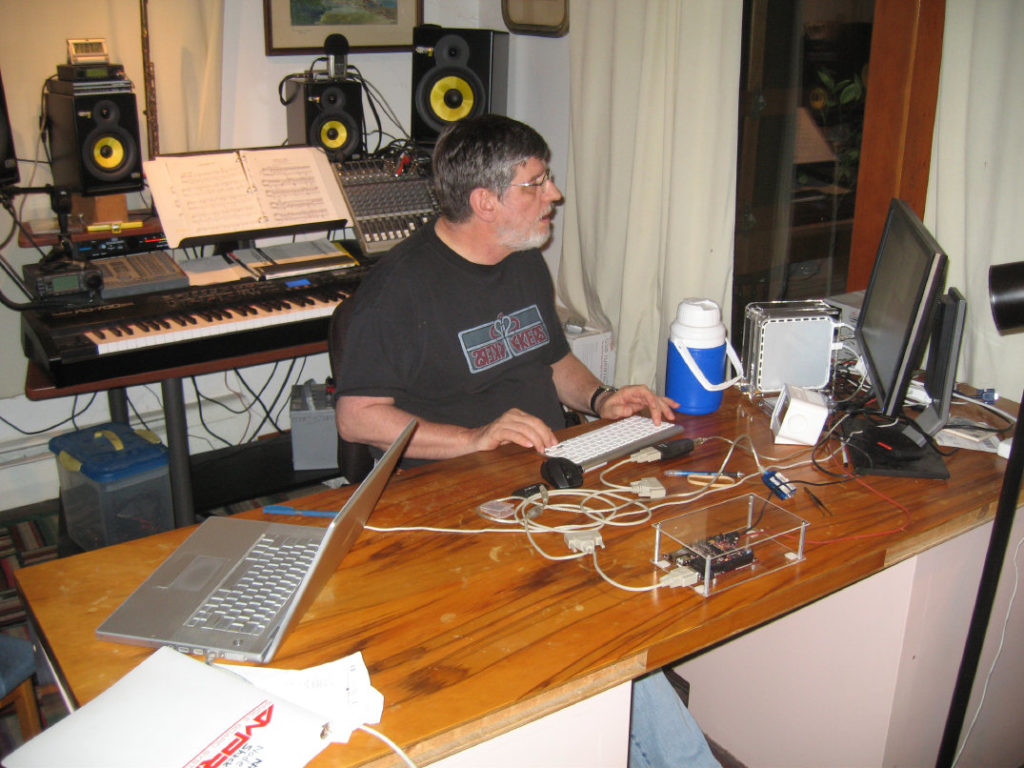
Miscellany
This is getting a little long, but there’s 5 months worth of catch-up. I’ll close with a few random tidbits.
First, in the process of fulfilling a Christmas gift hint from Sky, I set off on a quest to find a cushy hot-water bottle for cold Northwest nights aboard. Amazon’s most visible offering is the German Fashy brand, with various cover options, but it’s pricey; Etsy was iffy at best. But on eBay I found a friendly seller with two bottle sizes and a variety of fleece covers. I ended up buying a his ‘n hers pair; mine is the big plaid one and Sky’s is the cat’s paw 32-ouncer. Almost “body-weight proportional,” even:

It’s a great way to pre-heat a frigid berth, ease the back pain, or just improve general coziness.
I mentioned at the beginning of this long posting that I’ve had a safety valve for news in the orthogonal social media contexts of Twitter (@nomadness) and Facebook (where I prefer to “make friends” only with people I actually know on some level, though I’ve been known to accept invitions that suggest a good connection). This has been handy, and has reached the level of critical mass where I can ask a technical question and have a fairly good chance of getting an answer. I really miss the old Nomadness mailing list, which at one time was over 4000 people; I don’t think I ever failed to elicit useful information by simply mentioning a problem in an update. My Facebook and Twitter connections are each around 10% of that, but the easy low-granularity chat has made them useful… to the detriment of this blog, since I put something out of my mind once it’s “posted.” I’ll try to be better about that, since once things fade into the past over there they are effectively lost (except to Facebook’s massive data-mining servers, of course, which know all).
It’s rather sinister, actually, but fun and convenient. Isn’t that always how it goes?
Anyway, Happy New Year from Nomadness, and I look forward to reporting more frequently on the developing geekery!


Hi
Came across your neat page when searching for TS-7800 related activity.
Really liked your block diagram concept – I can relate to your “background thinking”. Something very special happens when you finally commit to writing it all down!
Would love to see a bigger version one day so I can see more details!
All the best,
Roy